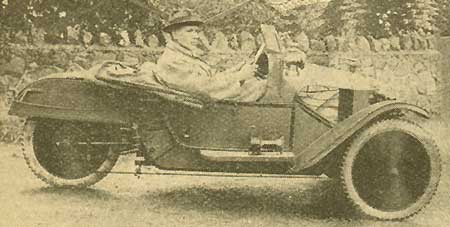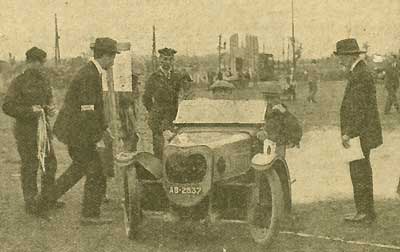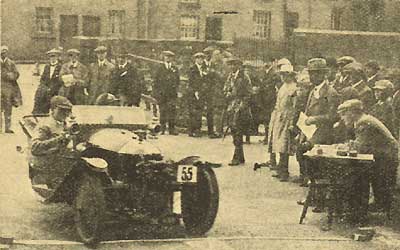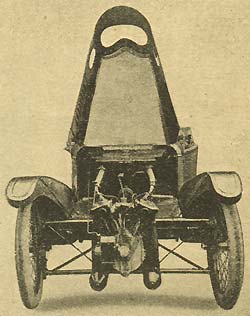An article, first published by:
The Light Car and Cyclecar
November 22, 1919
page 703 to 705


Three Wheels or Four?
An Expert Analysis of Rival Claims.
By H. B. DENLEY.

The writer on his Grand Prix Morgan, which has
figured in numerous trials.
ALTHOUGH I have driven many types of fourwheelers, I can only claim to have handled two makes of the three-wheeled variety. The first an ancient tricar, about which the less said the better; and the Morgan, of which make I have owned several models, with a total mileage approaching 50,000, not counting the journeys when the speedometer was hors de combat! In my opinion, the three-wheeler scores all the way from the point of view of initial cost, upkeep and general handiness.
Of course the first remark of the uninitiated is that three-wheelers skid. Certainly they do, so does every other vehicle in given circumstances — including a locomotive on wet rails; but the three-wheeler has the advantage in that it can skid considerably without the rear wheel getting outside the track of the front, a doubtful advantage, perhaps, but it has proved useful on occasion. Again, in taking sharp corners, the rear wheel is always inside the track of the front; in fact, I must plead guilty to forgetting sometimes to make sufficient allowance when driving a four and taking the rear wheel over the kerb!
Comfort and Economy.
When one considers that the man of moderate means is able to obtain nearly all the comforts of a car for little more than the price and running costs of a sidecar combination, why should he spend twice that amount for a fourwheeled car which costs more to run, is no more reliable and on an average long run is not as fast?
Apart from trials, which make a large difference to one's running costs (my average petrol consumption is 60 to 65 m.p.g. compared with a stiff reliability trial at 35 m.p.g.), I have kept a record of replacements due to ordinary touring conditions. The high-gear chain will run quite satisfactorily for 3,000 miles when it can be changed over to the low gear; the rear cover will do 4,000 miles, and is then quite good enough for the front. On the three-wheeler employing a twin rear wheel and all wheels interchangeable, this mileage should be improved considerably.
The four-wheeler is certainly ahead in having totally enclosed transmission, but the manufacturer of the three-wheeler is overtaking them in this respect, although this will need careful attention from the designer owing to the vibration and the need for quick detachability. The majority of light car owners are pleased with 35 m.p.g.; 60 m.p.g. is quite common on three-wheelers.
The Question of Rear Springing.
The rear springing leaves something to be desired when compared with a four, as with four wheels a given pot-hole conveys only half the shock to the occupants, whereas with the "three" the rear wheel drops in with a nasty jar. This question is one which requires very careful consideration from designers and reminds one of the words of a famous shipbuilder who said: "Any fool can design the bow, but it takes a man for the stern"; for the fitting of long, flexible springs might result in considerable side-roll.
I regret to note the tendency of three-wheel designers of water-cooled models to fix the radiator in front of the engine, as with so small a car it can only result in leaving an extremely small space in which to make any adjustments.

Mr. H. F. S. Morgan getting away in the steering test during the Junior Car Club's general efficiency trial.
There is a delightful simplicity about the transmission of the Morgan which makes it difficult to do any damage in changing gear. I had the misfortune to break an old low gear chain in town and the inevitable crowd of loungers were considerably astonished to see me throw the delinquent into the tool box and get away on high gear!
Might I make the suggestion here to manufacturers of both three and four-wheelers that they should consider the fitting of front wheel brakes? On so light a vehicle the retarding effect of rear brakes only is not sufficient, although the brakes in themselves are excellent, but there is insufficient weight on the wheels to prevent them sliding.
Turning to the thorny question of air versus water-cooling, there is no doubt that, up to the present, the water-cooled engine requires less attention and maintains its tune to a far greater extent than the aircooled model, although it will be very interesting to note the behaviour of the new air-cooled engines, as designers have benefited considerably from aero engine design.

The start of a memorable run in the M.C. and A.C. Open Trial. The Morgan made the best performance of the day — best passenger performance and also gained the private owner's prize.
It is when one has to obtain replacements that the three-wheeler really scores, it being much more accessible and at the same time easy for the average man to execute repairs satisfactorily for himself, which is a big consideration with the price of labour as it is to-day. After all, the cost of the actual repair is very small compared with the cost of dismantling "to get down to it" and afterwards to reassemble. Then the cost of spare parts for a three-wheeler is very much less than that for the four as everything is of a much simpler description. For example, a back axle for a three-wheeler would not cost as many shillings as a four-wheeler would pounds.
Wheel slip on greasy surfaces, a great bugbear of trial entrants, is less likely to give trouble on the "three," given equal conditions. In the first place, one usually finds a firmer surface in the centre of the road; in addition the rear wheel has the whole weight to make it grip, whereas the four has that weight divided between two wheels, with a differential to make matters worse.
An Impromptu Test.
We had an instructive impromptu test one day on a notoriously greasy hill between a Morgan and a well-known four-wheeled car. The Morgan got up without much trouble with an extra passenger on the tail, owing to its central drive, but on the car one wheel or other had to be loaded, and when we finally eliminated wheel spin we had too much weight aboard for the engine to tackle.
Where both wheels on certain four-wheeled cycle-cars are driven without a differential, I think there would be insufficient weight to enable the tyres to get below the surface grease and grip the firmer road below. An outstanding exception to this would be on hills such as Lynton and Countisbury (North
Devon), which have a strip of firm surface about a yard wide on one side of the road. On Lynton Hill, in a recent trial, I narrowly escaped failure owing
to wheel spin, whereas sidecar combinations got up in comparative comfort by hugging the side.
Turning to the question of accommodation for passengers and luggage, there is little to choose, except in the case of bodies wide enough to seat three abreast in fact there is more leg room in the Morgan for the "out size" driver than in many light cars I have examined. Tools and spares are carried under the seats in both types, and if an extra passenger be carried either in the dickey or on the tail this automatically bars luggage. The seat on the tail is hardly so luxurious as many dickies, but in an emergency answers just as well. Again, the light car or cyclecar owner usually looks after his own "bus" and there is certainly less surface to wash and polish.
Removing the Rear Wheel.
The only real grievance I have against the Morgan is the lack of quick detachability of the rear wheel. I always make a point of running a good cover, thus minimizing trouble with the puncture fiend; but the haunting fear is there on a rainy night far from home that the passenger may have to turn himself into a human candlestick. Although, in trials, drivers have been known to replace the rear tyre with a new one and be running again in 15 minutes, this is no mean feat. I notice that on some of the new makes this difficulty has been overcome, and there have been rumours at various times of the Morgan coming into line in this respect.

The accessibility of the engine is a marked feature
of the Morgan three-wheeler.
I have my doubts if a four-wheeler would hold the three in difficult country on account of width in narrow lanes and length on awkward corners. It would be very interesting to organize a light car trial over a course similar to that of the M.C. and A.C., which included sharp corners, long, narrow, tortuous hills, restarting on severe gradients and descents severely taxing the brakes. This would also give manufacturers an excellent idea of what to expect on six successive days in the Scottish Trials, which, if held over the motorcycle six days' course, would provide a severe test of the capabilities of both car and driver.
Referring to the proposed Scottish Trials, I think it will be a great pity if arrangements cannot be made to include three-wheelers. Some most interesting data would be produced, and as the three-wheeled runabout has already shown that it can hold its own amongst passenger motorcycles, its capabilities would probably be an eye-opener to many light car drivers. Is it because the three-wheeler is feared amongst the fours? In the recent Junior Car Club's General Efficiency Trial the three-wheeler gained second place in a field of over a dozen different makers of the opposing type.
Ease of handling is a great point in favour of the
three-wheeled runabout, with its low build, low centre of gravity and direct steering; in fact, during a recent thick fog, while overtaking a motorbus, I was only saved from a bad collision with a tramcar by being able to slip partly under the bodywork of the bus, which would have been impossible on an ordinary light car.
To sum up, the three-wheeler is the car for the man of moderate means who requires a speedy and reliable method of transport with a minimum of trouble, expense and garage space. As detachable wheels become general, combined with totally enclosed drive, the three-wheeler will hold an unassailable position in the eyes of both the business man and the tourist. May I add the usual disclaimer that I am in no way connected with the Morgan Motor Co., Ltd.?


Did you come through the backdoor and now you are missing the navigation bar?
 If you don't have the navigation bar on the left side, pressing the
"Homepage & Index"-Button below will bring you to our homepage and will load the frame with the links for easy navigation.
If you don't have the navigation bar on the left side, pressing the
"Homepage & Index"-Button below will bring you to our homepage and will load the frame with the links for easy navigation.








